What Animal Lives in the Kingdom of Axum
| Kingdom of Aksum መንግሥተ አኵስም (Ge'ez) | |||||||||||||||
|---|---|---|---|---|---|---|---|---|---|---|---|---|---|---|---|
| early on 1st century–c. 960 Advertising | |||||||||||||||
| Aksumite currency depicting King Endubis | |||||||||||||||
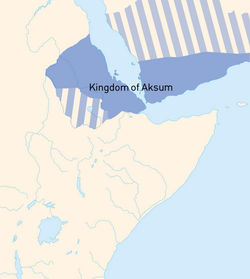 The Kingdom of Aksum at its greatest extent in the sixth century. | |||||||||||||||
| Majuscule |
| ||||||||||||||
| Common languages | (from 1st century) [2] | ||||||||||||||
| Religion |
| ||||||||||||||
| Demonym(s) | Aksumite, Ethiopian | ||||||||||||||
| Government | Monarchy | ||||||||||||||
| Negus | |||||||||||||||
| • c. 100 | Za Haqala (kickoff known) | ||||||||||||||
| • c. 940 | Dil Na'od (concluding) | ||||||||||||||
| Historical era | Classical antiquity to Early on Centre Ages | ||||||||||||||
| • Established | early 1st century | ||||||||||||||
| • Conquest of Meroe | 330 | ||||||||||||||
| 575/578 | |||||||||||||||
| • Conquest of Red Body of water by Rashidun Caliphate | 646 | ||||||||||||||
| • Sack of Aksum by queen Gudit | c. 960 AD | ||||||||||||||
| Expanse | |||||||||||||||
| 1,250,000 km2 (480,000 sq mi) | |||||||||||||||
| Currency | Aksumite currency | ||||||||||||||
| |||||||||||||||
The Kingdom of Aksum (Ge'ez: መንግሥተ አኵስም), besides known as the Kingdom of Axum or the Aksumite Empire, was a kingdom centered in Northeast Africa and S Arabia from Classical artifact to the Early Middle Ages. Based primarily in what is now northern Ethiopia, and spanned modernistic-day Eritrea, eastern Sudan, it extended territory at its height to mod Republic of yemen during the reign of King Kaleb. Axum served as the kingdom's capital for many centuries, but relocated to Jarma [4] in the 9th century due to declining its trade connection and recurring external invasion. [5] [6] Emerging from the earlier Dʿmt civilization, the kingdom was probable founded in the early 1st century. [7] Pre-Aksumite civilisation adult in part due to a S Arabian influence, evident in the Aksumite use of Aboriginal Southward Arabian script and the practise of Ancient Semitic religion. [8] Nonetheless, the Geʽez script came into use by the fourth century, and equally the kingdom became a major ability on the trade road between Rome and Republic of india, it entered the Greco-Roman cultural sphere and began to use Greek equally a lingua franca. [9] Information technology is through this that the Kingdom of Aksum adopted Christianity as the country faith in the mid-fourth century under Ezana of Axum. [10] Post-obit their Christianization, the Aksumites ceased structure of stelae. [5]
The kingdom was considered i of the aboriginal globe's four groovy powers of the 3rd century by Western farsi prophet Mani, alongside Persia, Rome, and China. [eleven] Beginning with the reign of Endubis, Aksum minted its ain coins which take been excavated in locations as far every bit Caesarea and southern India. [12] The kingdom connected to expand throughout late antiquity, conquering Meroe for a very curt period of fourth dimension, from whom it inherited the Greek exonym "Ethiopia". [13] Aksumite dominance in the Red Body of water culminated during the reign of Kaleb of Axum, who, at the behest of Byzantine emperor Justin I, invaded the Himyarite Kingdom in Yemen in order to end the persecution of Christians by the Jewish male monarch Dhu Nuwas. With the looting of Himyar, the Kingdom of Aksum was at its largest territorial extent. Notwithstanding, the territory was lost in the Aksumite–Farsi wars. [14]
The kingdom'due south tiresome decline had begun by the seventh century, at which signal currency ceased to be minted. The Persian (and later Muslim) presence in the Cherry-red Sea caused Aksum to suffer economically, and the population of the city of Axum shrank. Aslope environmental and internal factors, this has been suggested as the reason for the decline. Aksum'southward final three centuries are considered a dark age, and through uncertain circumstances, the kingdom collapsed around 960. [10] Despite its position as one of the foremost empires of late antiquity, the Kingdom of Aksum fell into obscurity equally Ethiopia remained isolated throughout the Heart Ages. [15]
History [ edit ]
Origins [ edit ]
Before the establishment of Axum, the Tigray plateau of Northern Ethiopia was home to a kingdom known as Dʿmt. Archaeological prove shows that the kingdom was influenced past Sabaeans from mod-twenty-four hour period Republic of yemen; scholarly consensus had previously been that Sabaeans had been the founders of Semitic civilization in Ethiopia, though this has at present been refuted, and their influence is considered to accept been small. [16] [a] [17] The Sabaean presence probable lasted simply for a matter of decades, but their influence on later Aksumite culture included the adoption of Ancient Due south Arabian script, which developed into Geʽez script, and Ancient Semitic religion. [eight]
The beginning historical mention of Axum comes from the Periplus of the Erythraean Sea , a trading guide which probable dates to the mid-1st century AD. Axum is mentioned alongside Adulis and Ptolemais of the Hunts as lying inside the realm of Zoskales. The surface area is described equally a producer of primarily ivory, besides as tortoise shells. Zoskales is also said to accept been "acquainted with Greek literature", indicating that Greco-Roman influence was already present at this time. [i] It is evident from the Periplus that, even at this early stage of its history, Axum played a function in the transcontinental trade route between Rome and India. [18]
A 1907 reproduction of the damaged painting Painting of the Vi Kings depicting the Ethiopian Emperor of Axum, created past an Umayyad Caliphate painter in the eighth century Advertising.
Empire [ edit ]
The Ezana Stone records negus Ezana's conversion to Christianity and his subjugation of various peoples near by, including Meroë.
Axumite Menhir in Balaw Kalaw (Metera) about Senafe
The Kingdom of Axum was a trading empire with its hub in Eritrea and northern Ethiopia. [nineteen] It existed approximately 100–940 AD, growing from the Iron Age proto-Axumite menstruation c. quaternary century BC to achieve prominence by the starting time century AD.
According to the Volume of Axum , the kingdom's first capital, Mazaber, was congenital past Itiyopis, son of Cush. [20] The majuscule was afterward moved to Axum in northern Ethiopia. The Kingdom used the name "Ethiopia" as early as the fourth century. [xvi] [21]
The Empire of Axum at times extended across about of present-day Eritrea, northern Federal democratic republic of ethiopia, Western Yemen, and parts of eastern Sudan. [21] The upper-case letter city of the empire was Axum, now in northern Federal democratic republic of ethiopia. Today a smaller community, the city of Axum was in one case a humming metropolis, cultural and economic hub. Two hills and two streams lie on the east and west expanses of the urban center; peradventure providing the initial impetus for settling this area. Forth the hills and plain outside the metropolis, the Aksumites had cemeteries with elaborate grave stones called stelee or obelisks. Other important cities included Yeha, Hawulti-Melazo, Matara, Adulis, and Qohaito, the concluding three of which are at present in Eritrea. Past the reign of Endubis in the belatedly tertiary century, it had begun minting its own currency and was named by Mani equally i of the 4 great powers of his fourth dimension along with the Sasanian Empire, Roman Empire, and "Three Kingdoms" Communist china. The Axumites adopted Christianity as the state religion in 325 or 328 Advertizement nether King Ezana, and Axum was the first land ever to utilise the epitome of the cross on its coins. [22] [23]
Effectually the third century (possibly c. 240–c. 260), the Aksumites led by Sembrouthes were victorious over the Sesea, with Sesea becoming a tributary of the Kingdom of Aksum. [24] [25] Around 330, Ezana of Aksum led his army into the Kingdom of Meroë, conquering and sacking the town itself. A big rock monument was left there, and the conquest is also related on Ezana Stone. [26]
King Kaleb [ edit ]
Around 525, King Kaleb sent an expedition to Yemen against the Jewish Himyarite rex Dhu Nuwas, who was persecuting the Christian community there. For well-nigh half a century south Arabia would get an Ethiopian protectorate under Abraha and his son Masruq. [27] Dhu Nuwas was deposed and killed and Kaleb appointed a Christian Himyarite, Esimiphaios ("Sumuafa Ashawa"), as his viceroy. However, around 530 this viceroy was deposed by the Aksumite general Abraha with back up of Ethiopians who had settled in Yemen. Kaleb sent two expeditions against Abraha, only both were decisively defeated. Kaleb did not pursue the matter further, and recognized Abraha every bit his new viceroy. [28]
Afterward Abraha'south decease, his son Masruq Abraha continued the Aksumite vice-royalty in Republic of yemen, resuming payment of tribute to Aksum. However, his half-brother Ma'd-Karib revolted.
After being denied by Justinian, Ma'd-Karib sought help from Khosrow I, the Sassanid Persian Emperor, thus triggering the Aksumite–Persian wars. Khosrow I sent a minor armada and ground forces under commander Vahrez to depose the king of Yemen. The war culminated with the Siege of Sana'a, capital of Aksumite Yemen. Subsequently its fall in 570, and Masruq death, Ma'd-Karib'due south son, Saif, was put on the throne.
In 575, the war resumed once again, after Saif was killed by Aksumites. The Persian full general Vahrez led another regular army of 8000, ending Axum rule in Republic of yemen and condign hereditary governor of Republic of yemen. According to Munro-Hay, these wars may take been Aksum's swan-song equally a bang-up power, with an overall weakening of Aksumite dominance and over-expenditure in money and manpower.[ commendation needed ]
According to Ethiopian traditions, Kaleb eventually abdicated and retired to a monastery. It is also possible that Ethiopia was affected by the Plague of Justinian around this time. [16]
Aksum, though weakened, remained a potent empire and trading power until the rise of Islam in the seventh century. Notwithstanding, dissimilar the relations between the Islamic powers and Christian Europe, Aksum (see Sahama), was on good terms with its Islamic neighbours and provided shelter to Muhammad's early followers effectually 615. [29] [30] Nonetheless, as early as 640, Umar sent a naval trek against Adulis, the Expedition of Alqammah bin Mujazziz, simply it was somewhen defeated. [31]
14th century analogy showing the king of Aksum declining the request of a Meccan delegation to yield upward the Muslims. It is also known as Kickoff Hegira
In the seventh century, early Muslims from Mecca sought refuge from Quraysh persecution by travelling to the kingdom, a journey known in Islamic history as the Offset Hegira. However the religion was not established until the arrival of the Ottomans in the 15th century. [32] [33]
Aksumite naval ability besides declined throughout the period, though in 702 Aksumite pirates were able to invade the Hejaz and occupy Jeddah. In retaliation, still, Sulayman ibn Abd al-Malik was able to take the occupied parts back and the Dahlak Archipelago from Aksum, which became Muslim from that point on.
Pass up [ edit ]
After a 2nd golden age in the early 6th century [16] the empire began to decline in the mid 6th century, [34] eventually ceasing its production of coins in the early seventh century. Around this aforementioned time, the Aksumite population was forced to go farther inland to the highlands for protection, abandoning Aksum as the uppercase. Arab writers of the time connected to describe Federal democratic republic of ethiopia (no longer referred to as Aksum) as an extensive and powerful land, though they had lost command of nigh of the coast and their tributaries. While land was lost in the north, it was gained in the south; and, though Federal democratic republic of ethiopia was no longer an economic ability, it notwithstanding attracted Arab merchants. The capital was moved to a new location, currently unknown, though it may take been called Ku'bar or Jarmi. [16]
Eventually, the Rashidun Caliphate took control of the Red Sea and Arab republic of egypt by 646, pushing Aksum into economic isolation. Northwest of Aksum, in modern-day Sudan, the Christian states of Nobatia, Makuria and Alodia lasted until the 13th century before beingness overrun by Bedouin tribes and the Funj Sultanate. Aksum, isolated, nonetheless still remained Christian. [16]
Famine is noted in Federal democratic republic of ethiopia in the 9th century. The patriarchates James (819-830) and Joseph (830-849) of Alexandria attribute Ethiopia'south condition to war, plague, and inadequate rains. [35] Under the reign of Degna Djan, during the 10th century, the empire kept expanding south, and sent troops into the modern-twenty-four hour period region of Kaffa, [36] while at the same fourth dimension undertaking missionary activity into Angot.
Local history holds that, effectually 960, a Jewish Queen named Yodit (Judith) or "Gudit" defeated the empire and burned its churches and literature. While there is testify of churches beingness burned and an invasion around this time, her beingness has been questioned by some western authors. Another possibility is that the Aksumite ability was ended by a southern pagan queen named Bani al-Hamwiyah, possibly of the tribe al-Damutah or Damoti (Sidama). It is clear from contemporary sources that a female usurper did indeed rule the country at this time, and that her reign ended some time earlier 1003. After a short Dark Age, the Aksumite Empire was succeeded by the Agaw Zagwe dynasty in the 11th or twelfth century (most probable effectually 1137), although express in size and scope. All the same, Yekuno Amlak, who killed the final Zagwe king and founded the modern Solomonic dynasty effectually 1270 traced his ancestry and his right to dominion from the last emperor of Aksum, Dil Na'od. It should exist mentioned that the end of the Aksumite Empire didn't mean the end of Aksumite culture and traditions; for example, the compages of the Zagwe dynasty at Lalibela and Yemrehana Krestos Church shows heavy Aksumite influence. [16]
Climate change hypothesis [ edit ]
Climatic change and trade isolation have also been claimed as big reasons for the decline of the civilization.[ citation needed ] The local subsistence base was substantially augmented past a climatic shift during the 1st century Advertising that reinforced the spring rains, extended the rainy season from 3 one/2 to 6 or vii months, vastly improved the surface and subsurface water supply, doubled the length of the growing season, and created an environment comparable to that of mod central Ethiopia (where two crops can exist grown per annum without the aid of irrigation). This appears to explicate how one of the marginal agricultural environments of Federal democratic republic of ethiopia was able to support the demographic base that made this far flung commercial empire possible. It may also explain why no Aksumite rural settlement expansion into the moister, more fertile, and naturally productive lands of Begemder or Lasta can be verified during the heyday of Aksumite power. As international profits from the substitution network declined, Aksum lost its power to control its ain raw material sources and that network complanate. The already persistent ecology pressure of a large population to maintain a high level of regional nutrient production had to exist intensified. The result was a wave of soil erosion that began on a local calibration c. 650 and attained catastrophic proportions after 700. Presumably complex socio-economic inputs compounded the problem. These are traditionally reflected in declining maintenance, deterioration and partial abandonment of marginal crop country, shifts to destructive pastoral exploitation, and eventual, wholesale and irreversible land deposition. This syndrome was possibly accelerated by an apparent decline in rainfall reliability start 730–760, with the presumed result that an abbreviated mod growing flavour was reestablished during the 9th century. [37]
Foreign relations, trade, and economy [ edit ]
Aksum was an of import participant in international trade from the 1st century AD (Periplus of the Erythraean Body of water) until circa the later part of the 1st millennium when information technology succumbed to a long decline against pressures from the diverse Islamic powers leagued against information technology.
The economically important northern Silk Road and southern Spice (Eastern) merchandise routes. The sea routes effectually the horn of Africa and the Indian sub-continent made Aksum an important trading port for almost a millennium.
Covering parts of what is at present northern Ethiopia and southern and eastern Eritrea, Aksum was deeply involved in the trade network betwixt the Indian subcontinent and the Mediterranean (Rome, afterward Byzantium), exporting ivory, tortoise shell, gold and emeralds, and importing silk and spices. [29] [30] Aksum's admission to both the Ruddy Sea and the Upper Nile enabled its strong navy to profit in merchandise between diverse African (Nubia), Arabian (Yemen), and Indian states.
The main exports of Aksum were, as would exist expected of a state during this time, agricultural products. The land was much more fertile during the time of the Aksumites than now, and their principal crops were grains such as wheat and barley. The people of Aksum also raised cattle, sheep, and camels. Wild animals were also hunted for things such as ivory and rhino horns. They traded with Roman traders as well every bit with Egyptian and Persian merchants. The empire was also rich with gold and atomic number 26 deposits. These metals were valuable to merchandise, merely another mineral was besides widely traded: salt. Salt was abundant in Aksum and was traded quite oft. [33] [32]
It benefited from a major transformation of the maritime trading arrangement that linked the Roman Empire and India. This change took place effectually the first of the 1st century. The older trading system involved littoral sailing and many intermediary ports. The Carmine Sea was of secondary importance to the Farsi Gulf and overland connections to the Levant. Starting around 100 BC a road from Egypt to Republic of india was established, making utilize of the Scarlet Ocean and using monsoon winds to cross the Arabian Body of water straight to southern India. By about 100 Advertizing, the volume of traffic being shipped on this road had eclipsed older routes. Roman demand for appurtenances from southern India increased dramatically, resulting in greater number of large ships sailing downwardly the Ruddy Bounding main from Roman Egypt to the Arabian Ocean and India. [38] [39]
The Kingdom of Aksum was ideally located to accept advantage of the new trading situation. Adulis soon became the master port for the export of African goods, such as ivory, incense, aureate, slaves, and exotic animals. In order to supply such goods the kings of Aksum worked to develop and expand an inland trading network. A rival, and much older trading network that tapped the same interior region of Africa was that of the Kingdom of Kush, which had long supplied Egypt with African goods via the Nile corridor. By the 1st century AD, however, Aksum had gained command over territory previously Kushite. The Periplus of the Erythraean Bounding main explicitly describes how ivory collected in Kushite territory was beingness exported through the port of Adulis instead of being taken to Meroë, the capital of Kush. During the second and 3rd centuries AD the Kingdom of Aksum connected to aggrandize their control of the southern Cherry-red Bounding main basin. A caravan route to Arab republic of egypt was established which bypassed the Nile corridor entirely. Aksum succeeded in becoming the chief supplier of African goods to the Roman Empire, non least as a upshot of the transformed Indian Ocean trading system. [41]
Club [ edit ]
The Aksumite population consisted of Semitic-speaking people, [42] [43] [44] Cushitic-speaking people, and Nilo-Saharan-speaking people (the Kunama and Nara).
Aksumites had a modified feudal organisation to farm the state. [22] [23]
Kings [ edit ]
The Aksumite kings had the official title ነገሠ ፡ ነገሠተ ngś ngśt – King of Kings (later vocalization Ge'ez ንጉሠ ፡ ነገሥት nigūśa nagaśt, Modern Ethiosemitic nigūse negest).
Culture [ edit ]
The Empire of Aksum is notable for a number of achievements, such as its own alphabet, the Ge'ez script, which was eventually modified to include vowels, becoming an abugida. Furthermore, in the early times of the empire, around 1700 years ago, giant obelisks to mark emperors' (and nobles') tombs (underground grave chambers) were constructed, the most famous of which is the Obelisk of Aksum.
Under Emperor Ezana, Aksum adopted Christianity in identify of its old polytheistic and Judaic religions effectually 325. This gave rise to the present day Ethiopian Orthodox Tewahedo Church (just granted autonomy from the Coptic Church building in 1959), and Eritrean Orthodox Tewahdo Church (granted autonomy from the Ethiopian Orthodox church in 1993). Since the schism with Orthodoxy following the Quango of Chalcedon (451), it has been an important Miaphysite church, and its scriptures and liturgy continue to be in Ge'ez. [29] [thirty]
Faith [ edit ]
Typical Aksumite architecture – the monastery of Debre Damo.
Before its conversion to Christianity, the Aksumites expert a polytheistic religion related to the religion expert in southern Arabia. This included the use of the crescent-and-disc symbol used in southern Arabia and the northern horn. [45] In the UNESCO sponsored General History of Africa French archaeologist Francis Anfray, suggests that the pagan Aksumites worshipped Astar, his son, Mahrem, and Beher. [46]
Coins of rex Endybis, 227–235 Advertizement. British Museum. The left 1 reads ΑΞΩΜΙΤΩ BICIΔΑΧΥ, possily "human being of Dachu, (king) of Axumites", linguistically mixed(?). The right one reads in Greek ΕΝΔΥΒΙC ΒΑCΙΛΕΥC, "King Endybis".
Steve Kaplan argues that with Aksumite civilization came a major change in religion, with only Astar remaining of the old gods, the others being replaced past what he calls a "triad of indigenous divinities, Mahrem, Beher and Medr." He likewise suggests that Aksum civilization was significantly influenced by Judaism, saying that "The first carriers of Judaism reached Ethiopia betwixt the reign of Queen of Sheba BC and conversion to Christianity of Male monarch Ezana in the fourth century Air-conditioning." He believes that although Ethiopian tradition suggests that these were nowadays in large numbers, that "A relatively small number of texts and individuals habitation in the cultural, economical, and political center could have had a considerable touch." and that "their influence was diffused throughout Ethiopian culture in its formative menstruum. By the time Christianity took hold in the quaternary century, many of the originally Hebraic-Jewish elements had been adopted past much of the indigenous population and were no longer viewed as foreign characteristics. Nor were they perceived as in conflict with the acceptance of Christianity." [47]
Earlier converting to Christianity, King Ezana II'southward coins and inscriptions show that he might have worshiped the gods Astar, Beher, Meder/Medr, and Mahrem. Another of Ezana's inscriptions is conspicuously Christian and refers to "the Father, the Son, and the Holy Spirit". [48] Effectually 324 AD the King Ezana 2 was converted to Christianity by his teacher Frumentius, the founder of the Ethiopian Orthodox Church. [33] [32] Frumentius taught the emperor while he was young, and information technology is believed that at some betoken staged the conversion of the empire. [38] [39] We know that the Aksumites converted to Christianity because in their coins they replaced the disc and crescent with the cantankerous. Frumentius was in contact with the Church of Alexandria, and was appointed Bishop of Ethiopia around the year 330. The Church building of Alexandria never closely managed the diplomacy of the churches in Aksum, allowing them to develop their own unique form of Christianity. [22] [23] Nevertheless, the Church of Alexandria probably did retain some influence because that the churches of Aksum followed the Church building of Alexandria into Oriental Orthodoxy by rejecting the Fourth Ecumenical Council of Chalcedon. [49] Aksum is as well the alleged abode of the holy relic the Ark of the Covenant. The Ark is said to have been placed in the Church of Our Lady Mary of Zion by Menelik I for safekeeping. [29] [xxx]
Islam came in the seventh century at the reign of Ashama ibn-Abjar when the followers of the Prophet Muhammed were persecuted by the ruling tribe and begun migrating after the first followers got asylum from the King many begun to migrate. All of them returned to Medina in 622.source?
Ethiopian sources [ edit ]
Ethiopian sources such as the Kebra Nagast and the Fetha Nagast [32] [33] draw Aksum as a Jewish Kingdom. The Kebra Nagast contains a narrative of how the Queen of Sheba/Queen Makeda of Federal democratic republic of ethiopia met King Solomon and traces Ethiopia's to Menelik I, her son by King Solomon of State of israel. In its existing course, the Kebra Nagast is at least 700 years old and is considered by the Ethiopian Orthodox Tewahedo Church to be a reliable and historic work.
Coinage [ edit ]
The Empire of Aksum was one of the showtime African polities to outcome its own coins, [38] [39] which bore legends in Ge'ez and Greek. From the reign of Endubis upwards to Armah (approximately 270 to 610), gold, silver and statuary coins were minted. Issuing coinage in aboriginal times was an act of great importance in itself, for it proclaimed that the Aksumite Empire considered itself equal to its neighbours. Many of the coins are used as signposts about what was happening when they were minted. An example being the improver of the cross to the coin after the conversion of the empire to Christianity. The presence of coins also simplified trade, and was at once a useful instrument of propaganda and a source of turn a profit to the empire.
Architecture [ edit ]
Homely architecture [ edit ]
In general, aristocracy Aksumite buildings such as palaces were synthetic atop podia congenital of loose stones held together with mud-mortar, with carefully cut granite corner blocks which rebated back a few centimeters at regular intervals equally the wall got college, and then the walls narrowed every bit they rose higher. These podia are often all that survive of Aksumite ruins. Above the podia, walls were generally built with alternating layers of loose rock (often whitewashed, like at Yemrehana Krestos Church) and horizontal wooden beams, with smaller round wooden beams gear up in the stonework often projecting out of the walls (these are called 'monkey heads') on the exterior and sometimes the interior. Both the podia and the walls above exhibited no long straight stretches but were indented at regular intervals and so that any long walls consisted of a series of recesses and salients. This helped to strengthen the walls. Worked granite was used for architectural features including columns, bases, capitals, doors, windows, paving, water spouts (often shaped similar lion heads) and then on, equally well as enormous flights of stairs that often flanked the walls of palace pavilions on several sides. Doors and windows were ordinarily framed by rock or wooden cross-members, linked at the corners by square 'monkey heads', though simple lintels were also used. Many of these Aksumite features are seen carved into the famous stelae as well as in the after stone hewn churches of Tigray and Lalibela. [16]
Palaces unremarkably consisted of a central pavilion surrounded past subsidiary structures pierced by doors and gates that provided some privacy (see Dungur for an example). The largest of these structures now known is the Ta'akha Maryam, which measured 120 × 80m, though as its pavilion was smaller than others discovered it is probable that others were even larger. [16]
Some clay models of houses survive to give us an idea of what smaller dwellings were like. 1 depicts a round hut with a conical roof thatched in layers, while another depicts a rectangular house with rectangular doors and windows, a roof supported by beams that end in 'monkey heads', and a parapet and water spout on the roof. Both were constitute in Hawelti. Another depicts a square house with what appear to be layers of pitched thatch forming the roof. [xvi]
Stelae [ edit ]
The stelae (hawilt/hawilti in local languages) are perchance the most identifiable role of the Aksumite architectural legacy. These stone towers served to marking graves and stand for a magnificent multi-storied palace. They are decorated with false doors and windows in typical Aksumite design. The largest of these towering obelisks would measure 33 meters loftier had information technology not fractured. The stelae have about of their mass out of the ground, but are stabilized by massive underground counter-weights. The rock was frequently engraved with a blueprint or emblem denoting the king'south or the noble's rank. [22] [23]
In literature [ edit ]
The Aksumite Empire is portrayed as the main marry of Byzantium in the Belisarius series by David Drake and Eric Flint published by Baen Books. The series takes place during the reign of Kaleb, who in the series was assassinated by the Malwa in 532 at the Ta'akha Maryam and succeeded by his youngest son Eon bisi Dakuen.
In the Elizabeth Wein serial The King of beasts Hunters, Mordred and his family take refuge in Aksum after the fall of Camelot. Kaleb is the ruler in the first book; he passes his sovereignty onto his son Gebre Meskal, who rules during the Plague of Justinian.
Gallery [ edit ]
Run into also [ edit ]
Notes [ edit ]
- ^ According to Munro-Hay, "The arrival of Sabaean influences does not stand for the offset of Ethiopian civilisation.... Semiticized Agaw peoples are thought to take migrated from south-eastern Eritrea possibly as early every bit 2000 BC, bringing their 'proto-Ethiopic' language, ancestor of Ge'ez and the other Ethiopian Semitic languages, with them; and these and other groups had already developed specific cultural and linguistic identities by the time whatever Sabaean influences arrived." [16]
References [ edit ]
- ^ a b "The Periplus of the Erythraean Ocean: Travel and Trade in the Indian Ocean by a Merchant of the Starting time Century". Fordham University Net History Sourcebooks, chapters four and 5.
- ^ "Snowden Lectures: Stanley Burstein, When Greek was an African Language". The Middle for Hellenic Studies. 2022-11-02. Retrieved 2022-02-23 .
- ^ Turchin, Peter and Jonathan M. Adams and Thomas D. Hall: "East-West Orientation of Historical Empires and Modern States", p. 222. Periodical of World-Systems Research, Vol. XII, No. Ii, 2006
- ^ Burstein, Stanley (2015), Benjamin, Craig (ed.), "Africa: states, empires, and connections", The Cambridge Earth History: Volume four: A Globe with States, Empires and Networks 1200 BCE–900 CE, The Cambridge Earth History, Cambridge: Cambridge Academy Press, vol. 4, pp. 631–661, ISBN 978-1-139-05925-ane , retrieved 2022-02-xix
- ^ a b Phillipson, David Due west. (2012). Foundations of an African Civilisation: Aksum & the Northern Horn, one thousand BC - Advertizement 1300. Woodbridge: James Currey. p. 48. ISBN 978-1-84701-041-4 .
- ^ Butzer, Karl W. (1981). "Rising and Autumn of Axum, Federal democratic republic of ethiopia: A Geo-Archaeological Interpretation". American Antiquity. Cambridge Academy Press. 46 (3): 471–495. doi:10.2307/280596. JSTOR280596. S2CID162374800.
- ^ Munro-Hay, Stuart (1991). Aksum: An African Civilisation of Late Antiquity. Edinburgh: Edinburgh University Press. p. 69. ISBN 0748601066 .
- ^ a b Munro-Hay, Stuart (1991). Aksum: An African Civilisation of Late Antiquity. Edinburgh: Edinburgh University Press. pp. 61–62. ISBN 0748601066 .
- ^ Munro-Hay, Stuart (1991). Aksum: An African Civilisation of Late Antiquity. Edinburgh: Edinburgh University Press. p. 5. ISBN 0748601066 .
- ^ a b Derat, Marie-Laure (2022). "Earlier the Solomonids: Crisis, Renaissance and the Emergence of the Zagwe Dynasty (Seventh–Thirteenth Centuries)". In Kelly, Samantha (ed.). A Companion to Medieval Federal democratic republic of ethiopia and Eritrea. Leiden: Brill. p. 34. ISBN 978-ninety-04-41958-2 .
- ^ Munro-Hay, Stuart (1991). Aksum: An African Civilisation of Tardily Artifact. Edinburgh: Edinburgh Academy Press. p. 17. ISBN 0748601066 .
- ^ Hahn, Wolfgang (2000). "Askumite Numismatics - A critical survey of recent Research". Revue Numismatique. 6 (155): 281–311. doi:ten.3406/numi.2000.2289 . Retrieved ix September 2022.
- ^ Munro-Hay, Stuart (1991). Aksum: An African Civilisation of Late Antiquity. Edinburgh: Edinburgh University Press. pp. fifteen–sixteen. ISBN 0748601066 .
- ^ Munro-Hay, Stuart (1991). Aksum: An African Civilisation of Late Antiquity. Edinburgh: Edinburgh University Press. p. 55. ISBN 0748601066 .
- ^ Fritsch, Emmanuel; Kidane, Habtemichael (2022). "The Medieval Ethiopian Orthodox Church and Its Liturgy". In Kelly, Samantha (ed.). A Companion to Medieval Ethiopia and Eritrea. Leiden: Brill. p. 169. ISBN 978-90-04-41958-2 .
- ^ a b c d e f one thousand h i j k Munro-Hay, Stuart (1991). Aksum: An African Culture of Late Artifact (PDF). Edinburgh: University Press. p. 57. Archived from the original (PDF) on January 23, 2013. Retrieved February 1, 2013.
- ^ Pankhurst, Richard One thousand. P. (January 17, 2003). "Permit's Expect Across the Red Sea I". Addis Tribune. Archived from the original on January 9, 2006. Retrieved February 1, 2013.
- ^ Phillips, Jacke (2016). "Aksum, Kingdom of". In MacKenzie, John M. (ed.). The Encyclopedia of Empire. Hoboken: John Wiley & Sons, Ltd. pp. 1–2. ISBN 9781118455074 .
- ^ Phillipson, David (2012). Neil Asher Silberman (ed.). The Oxford Companion to Archaeology . Oxford Academy Press. p. 48. ISBN 978-0-19-973578-v .
- ^ Africa Geoscience Review . Rock View International. 2003-01-01. p. 366.
- ^ a b Henze, Paul B. (2005) Layers of Time: A History of Federal democratic republic of ethiopia, ISBNi-85065-522-seven.
- ^ a b c d http://users.clas.ufl.edu/sterk/junsem/haas.pdf [ bare URL PDF ]
- ^ a b c d "Aksum".
- ^ Thonemann, Peter (2013), "Phrygia: an anarchist history, 950 BC–Advertisement 100", in Thonemann, Peter (ed.), Roman Phrygia, Cambridge University Printing, pp. 1–40, doi:10.1017/cbo9781139381574.002, ISBN 978-1-139-38157-4
- ^ "The Christian Topography of Cosmas Indicopleustes". Nature. 84 (2127): 133–134. August 1910. Bibcode:1910Natur..84..133.. doi:10.1038/084133a0. hdl: 2027/coo1.ark:/13960/t07w6zm1b . ISSN0028-0836. S2CID3942233.
- ^ Stanley M. Burstein, "Axum and the Fall of Meroe, Journal of the American Inquiry Centre in Arab republic of egypt Vol. eighteen (1981), pp. 47–fifty
- ^ electricpulp.com. "ABNĀʾ – Encyclopaedia Iranica". world wide web.iranicaonline.org . Retrieved 2022-04-13 .
- ^ Coffin, J. B. (1923). History of the Later Roman Empire. Vol. II. Macmillan & Co. pp. 325–326.
- ^ a b c d The British Museum; The CarAf Centre. "The wealth of Africa – The kingdom of Aksum: Teachers' notes" (PDF). BritishMuseum.org. Archived from the original (PDF) on iv November 2022.
- ^ a b c d "Daily Life in Aksum" (PDF). world wide web.hmhco.com/ (formerly eduplace.com). Research Reports: Daily Life in Ancient Times. Houghton Mifflin Company. Archived from the original (PDF) on 3 Baronial 2022.
- ^ E. Cerulli, "Ethiopia'southward Relations with the Muslim World" in Cambridge History of Africa: Africa from the Seventh to the Eleventh century, p. 575; Trimingham, Spencer, Islam in Ethiopia, p. 46.
- ^ a b c d Bekerie, Ayele. "The Rise of the Askum Obelisk is the Rise of Ethiopian History" (PDF). Newark, USA: Rutgers University. Archived from the original (PDF) on 2017-01-07. Retrieved 2017-01-06 .
- ^ a b c d "GoBlues - Asheville School" (PDF).
- ^ David W. Phillipson (2012): Foundations of an African Civilisation: Aksum and the Northern Horn, 1000 BC – AD 1300. James Currey. p. 209
- ^ Evetts, B.: "History of the Patriarchs of the Coptic Church building of Alexandria", by Sawirus ibn al-Mukaffa', bishop of al-Ashmunien, Vol I, IV, Menas I to Joseph, PO X fasc. v. pp 375-551, Paris, 1904
- ^ Werner J. Lange, "History of the Southern Gonga (southwestern Ethiopia)", Steiner, 1982, p. 18
- ^ Karl W. Butzer, "Rise and Fall of Axum, Ethiopia: A Geo-Archaeological Interpretation", American Artifact 46, (July 1981), p. 495
- ^ a b c http://www.ruperthopkins.com/pdf/Kingdom_of_Axum.pdf [ bare URL PDF ]
- ^ a b c Záhoří, January (February 2014). "Review: Phillipson, (2012). Foundations of an African civilization: Aksum & the Northern Horn, thou BC - Advertisement 1300" (PDF). Archived from the original (PDF) on 2017-01-07. Retrieved 2017-01-06 .
- ^ De Lorenzi, James (2015), Guardians of the Tradition: Historians and Historical Writing in Ethiopia and Eritrea, Rochester: University of Rochester Press, pp. 15–sixteen, ISBN978-1-58046-519-9.
- ^ The effect of the Indian Ocean trading system on the rise of Aksum is described in State Formation in Aboriginal Northeast Africa and the Indian Ocean Trade Archived 2009-01-xiv at the Wayback Machine, by Stanley Yard. Burstein.
- ^ Crawford Immature, The Ascension Tide of Cultural Pluralism: The Nation-state at Bay?, (University of Wisconsin Printing: 1993), p. 160
- ^ Rainer Baudendistel, Between Bombs and Adept Intentions: The Reddish Cross and the Italo-Ethiopian War, (Berghahn Books: 2006), p. 320
- ^ George Kurian, Lexicon of world politics, (CQ Press: 2002), p. 150
- ^ Phillipson, David (2012). Foundations of an African Civilization: Aksum and the northern Horn, 1000 BC – Advertisement 1300 . James Currey. p. 91. ISBN 978-1847010414 .
- ^ Chiliad. Mokhtar, ed. (1990). UNESCO Full general History of Africa: Ancient Africa v. 2. Academy of California Press. p. 221. ISBN 978-0520066977 .
- ^ Kaplan, Steve (1994). The Beta State of israel (Falasha) in Ethiopia: From the Primeval Times to the Twentieth Century. New York University Press. ISBN 978-0814746646 .
- ^ Munro-Hay, Stuart (2010). Henry Louis Gates Jr., Kwame Anthony Appiah (ed.). Encyclopedia of Africa Vol. I . Oxford University press. p. 77. ISBN 978-0195337709 .
- ^ Wybrew, Hugh. "A History of Christianity in the Middle East & Due north Africa". Jerusalem & Middle East Church Association. Retrieved 25 February 2013.
Further reading [ edit ]
- Bausi, Alessandro (2022). "Translations in Late Antique Federal democratic republic of ethiopia" (PDF). Egitto Crocevia di Traduzioni. EUT Edizioni Università di Trieste. ane: 69–100. ISBN 978-88-8303-937-9 .
- Phillipson, David W. (1998). Ancient Ethiopia. Aksum: Its Antecedents and Successors. The British Museum Press. ISBN 978-0-7141-2763-seven .
- Phillipson, David W. (2012). Foundations of an African culture: Aksum & the Northern Horn, 1000 BC - AD 1300. Woodbridge, Suffolk: James Currey. ISBN 978-1-84701-088-9 . </ref>
- Yule, Paul A., ed. (2013). Late Antique Arabia Ẓafār, Capital of Ḥimyar, Rehabilitation of a 'Decadent' Social club, Excavations of the Ruprecht-Karls-Universität Heidelberg 1998–2010 in the Highlands of the Yemen. Abhandlungen Deutsche Orient-Gesellschaft, vol. 29, Wiesbaden, pp. 251–54. ISBN 978-3-447-06935-9 .
External links [ edit ]
- World History Encyclopedia – Kingdom of Axum
- East-West Orientation of Historical Empires and Modern States at the Wayback Machine (archived February 22, 2007)
- Ethiopian Treasures – Queen of Sheba, Aksumite Kingdom – Aksum
- Ancient History Sourcebook: Accounts of Meröe, Kush, and Axum
- Aksum: UNESCO World Heritage Site
- The Ash Heap of History (Mises.org)
What Animal Lives in the Kingdom of Axum
Source: https://en.wikipedia.org/wiki/Kingdom_of_Aksum
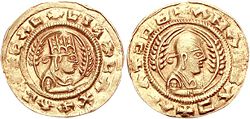
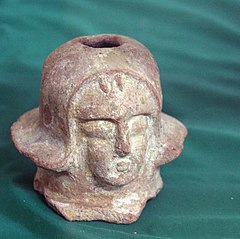
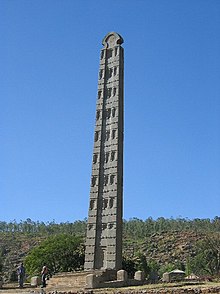



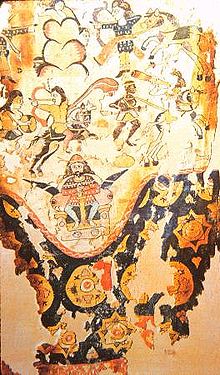
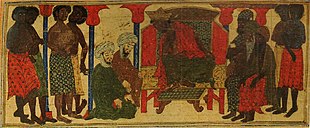
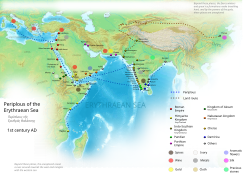




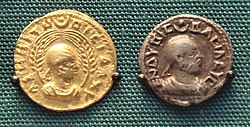



















Comments
Post a Comment